Birth of a Family
Tasha Hubbard
2017
| 79 min 14 s
Prizes and awards
Official SelectionHot Docs 2017
Official SelectionCinefest Sudbury 2017
Official SelectionCalgary International Film Festival 2017
Special Jury PrizeimagineNATIVE Film and Media Arts Festival 2017
Audience Choice AwardEdmonton International Film Festival 2017
Official SelectionCinequest Film & VR Festival 2017
Kathleen Shannon AwardYorkton Film Festival 2018
“We grew up in white homes, speaking only English and with no connection to our people or our culture. Though we were loved, we were outsiders in families that had grandparents, aunts, uncles and cousins that were not ours.” Betty Ann Adam
When is a family reunion not a reunion?
When your family has never met.
Synopsis
Three sisters and a brother, adopted as infants into separate families across North America, meet together for the first time in this deeply moving documentary by director Tasha Hubbard.
Removed from their young Dene mother’s care as part of Canada’s infamous Sixties Scoop, Betty Ann, Esther, Rosalie and Ben were four of the 20,000 Indigenous children taken from their families between 1955 and 1985, to be either adopted into white families or to live in foster care. Now all in middle age, each has grown up in different circumstances, with different family cultures, different values and no shared memories. Birth of a Family follows them through the challenges, trepidations and joys of their first steps towards forming their family.
Meeting all together for the first time, they spend a week in Banff, Alberta, sharing what they know about their mother and stories about their lives and the struggles they went through as foster kids and adoptees. As the four siblings piece together their shared history, their connection deepens, bringing laughter with it, and their family begins to take shape.
When is a family reunion not a reunion?
When your family has never met.
Three sisters and a brother, adopted as infants into separate families across North America, meet together for the first time in this deeply moving documentary by director Tasha Hubbard.
Removed from their young Dene mother’s care as part of Canada’s infamous Sixties Scoop, Betty Ann, Esther, Rosalie and Ben were four of the 20,000 Indigenous children taken from their families between 1955 and 1985, to be either adopted into white families or to live in foster care. After a decades-long search, Betty Ann, the oldest, has tracked down her siblings, one by one. Now all in middle age, each has grown up in different circumstances, with different family cultures, different values and no shared memories. Birth of a Family follows them through pain, trepidation and laughter as they work together to build their family.
With deep sensitivity and an almost invisible presence, Hubbard follows the siblings as they meet in Banff, Alberta, all four together for the first time. Everything is new to them: their ancestry, their culture, their language, and one another. Before their meeting, they are hopeful but apprehensive, wondering how they will relate to one another, knowing full well how hard it will be to reclaim what has been missing all their lives.
Over their week together in Banff, they talk about their lives and the struggles they went through as foster kids and adoptees. Betty Ann, the only one who’s met their mother, Mary Jane, shares with her younger siblings what she knows about her as a person and the impact residential school may have had on her.
Hearing anecdotes and seeing photos of their mother allows the sisters and their brother insight into her life. Each new story about her is both a gift and a poignant reminder of what they lost. As the four siblings piece together their shared history, their connection deepens and a fledgling family dynamic evolves.
Promotional Materials
Trailer
Clip #1
Clip #3
Clip #2
Clip #4
Clip #5
Q & A with Tasha Hubbard
1. Your main subject, Betty Ann, is an established journalist who has wanted to tell her family’s story her whole life. She protected it fiercely when media outlets pursued her for it over the years, but trusted you to tell it. How did you establish that trust with her and then later with her siblings, Rosalie, Esther and Ben?
Betty Ann and I connected during the making of Two Worlds Colliding, my 2004 documentary about Darrell Night, a Native man who was dumped by police on the outskirts of Saskatoon in the middle of winter. Betty Ann was one of the journalists covering the story; we had many conversations over the years about the issues raised in that film. A couple of years ago, we realized that it was coming up on the 10th anniversary of the release of Two Worlds Colliding and worked together to organize an event in Saskatoon.
We had also shared our similar backgrounds with each other. So by the time Betty Ann came to me with the project, she understood that I understood what it would be like to get together with siblings who hadn’t met before. At the time, I wasn’t sure that I could take on a new project, and we talked about her potentially directing it with me helping, but in the end it made sense for me to direct because it’s such a personal story for her. She felt a sense of responsibility to her family first, so it was best for me to take on the responsibility of making the film. We built on that initial trust through conversations about the process and intent of the film, and she was so courageous about letting someone else guide the story.
And Betty Ann had, of course, talked to her siblings about me prior to me meeting them. And when I went out to meet them, I didn’t film them right away, I just spent time talking across the table. I try to share with people in my films who I am and why I am making the film, because I’m going to be asking them questions about themselves, so that it’s reciprocal. In this case, it was more significant because what they were about to do was something I had also done: meet my own siblings for the first time. They had questions that I was willing to answer; it just came down to having really honest conversations. So by the time we filmed them all meeting at the airport, they already knew that I cared about their story.
2. This film deals with some very painful issues. Betty Ann, Rosalie, Esther and Ben would have all had very different lives if they had grown up together or at least been allowed contact with one another. As a human being, you wanted to be respectful of their need to connect and find real rapport with one another, but as a director, you also needed to tell a story. What were some of the challenges you faced in negotiating that balance?
One of the things we agreed upon with Betty Ann, Rosalie, Esther and Ben was that we were there at their invitation and that they retained control of the situation. We told them it was ok to ask us to leave at any time because, as a director, I am trying to tell a story, but it’s a monumental moment in their lives and I didn’t want to ruin that in any way. We agreed on some basic parameters: that we’d have two cameras so, as much as possible, we’d minimize having to do things over, and we’d try not to have them wait for us to set up.
They determined what they wanted to do and when, and we would just respond. I assured them that it wasn’t going to be filmed like reality television; they wouldn’t wake up with a camera in their face! We were going to do our best to show what their days were like in their quest to become a family, striking a delicate balance each day, trying not to push things too far, but also trying to capture the essence of what they experienced.
One of the days was a big outing where they went to the ice fields and walked the skywalk, and there were a few little glitches where they had to wait for us. The next day they planned to go on the gondola, and I just made the call and said, You know what, we’re not going to come, we’re going to rest up for the evening shoot and you’re going to have an outing without us there. They were pretty happy about it, but when they came back from the outing, they’d had such a good time, they were like: We wish you had been there! It was very touching that they’d wanted us to see and experience it with them.
3. Your filmmaking style varies from hard-hitting political documentaries such as Two Worlds Colliding to lyrical animation such as Buffalo Calling. With Birth of a Family, you have chosen a very empathetic observational approach. Was this a conscious choice, or did it evolve organically as you worked with Betty Ann?
I think this is partly because I didn’t go to film school. I’ve always learned from mentors and by doing. I love the challenge of making a film in a style that’s new to me. With Two Worlds Colliding, my first film on my own, I had support and guidance, but for me it was learning how to tell a very intense story: What was the best way to do it? When I was done, I was like, Ok, I did that, and I could make a film like that again, and maybe I will in the future, but now I’d like to do something else. Buffalo Calling was a challenge to myself: How could I tell a story without words, in a purely visual way?
And when it came to Birth of a Family, I had been watching observational documentaries from the 70s for a film class I was teaching and I thought, I’ve never made one like that. I’d also seen the documentary Western by the Ross brothers at Hot Docs in 2015 and loved how they immersed themselves and brought that world to the audience without narration. Shortly after, the NFB came on board and producer Bonnie Thompson asked me how I wanted to approach this film. I wanted the audience to look at their own families and think about what it would be like if they hadn’t grown up together and had all these shared experiences. I felt as though seeing things unfold instead of being told about them would ultimately be more powerful.
4. Part of the intimacy and access of Birth of a Family is due to the special insight you have into Betty Ann, Rosalie, Esther and Ben’s experience. Could you talk a little bit about your history and how that informed your approach to this film?
I was surrendered as a newborn to social services by my birth mother. My mother was very young and my dad had been through some of the things a lot of Indigenous people of his generation had been through, like residential school. I was adopted at three months by a young farming couple in Saskatchewan. My adoptive dad passed away when I was young, and my adoptive mum made a commitment to support me and connect me to my birth family when I was old enough. She and I started looking for my birth parents when I was 15.
We came up with dead ends with social services and Indian Affairs, so my stepdad suggested a Cree lawyer he’d gone to high school with. He found my parents right away, so I met them both about three weeks apart, and then over a period of five years I gradually met my half siblings, 10 in total. So I’d gone through the same thing as Betty Ann, Rosalie, Esther and Ben, having siblings who look like me, have the same gestures as me, with no history. We’ve been pretty fortunate over the years to create our own memories and now some of us are parents ourselves; we’ve been able to create family bonds but it’s not always easy. So I understand the loss they feel; I can relate to that as well. It helped in the filming process and also helped in the editing, how we put the story together.
People sometimes take family for granted; part of the beauty of this film is that Betty Ann, Rosalie, Esther and Ben don’t. They really don’t. And family is the beginning of all our relationships, and to not have been able to have that with each other is sad. And even though they are able to start to create a sense of family, it doesn’t erase those years of loss.
Q & A with Betty Ann Adam
1. This is a profoundly important story for you, one you had been wanting to tell for a long time. You initiated this film and were also the co-writer, but you are also the main subject. How was the experience of being both a storyteller and a subject for you?
In the years when I searched for my siblings and worked to execute our mother’s estate, the goal of bringing us all together sometimes felt like an unrealistic fantasy.
When I talked to my closest friends about what I was doing, it felt like I was telling installments of a longer narrative. I had a vague idea of writing my experience but I’d thought of doing it in a novel.
I had declined to give interviews to journalists who were interested. It was my story to tell.
When I set out to make a film about my family’s first gathering, I sought advice from Tasha Hubbard but soon realized there was too much I didn’t know about the craft.
I was relieved and delighted when she agreed to take on the project because I so admire her work. I hadn’t dared to ask her to help me because I knew she was working on her PhD, teaching, raising her young son and working on other films.
I trusted her completely, in part because her own experience is like mine in many ways.
I always felt like we were in good hands. Tasha and producer Bonnie Thompson gave us space to have our experience without interference while still having the microphones and cameras on.
My role in the storytelling was mainly in the conversations I had with them before, a little bit during and some after the shooting. We wanted to leave room for spontaneity while having at least a rough itinerary for the crew and time for the production manager, Darin Wilson, to get approvals for shooting where necessary within the park and businesses.
My first priority was being with my sisters and brother, so ignoring the cameras was fairly easy.
They all took the filming in stride. I think for them it was just another delightful element of the entire, surprising episode of having family appear from out of the blue and then finding ourselves living together and exploring the gorgeous environment as sisters and brother.
The entire experience often felt surreal. I had difficulty concentrating and often couldn’t even do simple addition. Every time we went into town, we got lost.
2. With your decades as a staff reporter at the Saskatoon Star Phoenix, you are a seasoned storyteller. Were there aspects of this story that are not in the film that you would like to talk about?
This film would not have been made if not for Commissioner Marie Wilson of the Truth and Reconciliation Commission on Indian Residential Schools.
I saw her speak in Saskatoon on April 1, 2015, where she talked about the upcoming closing ceremonies of the TRC and invited communities to host their own events. Her observations on the commission’s work and findings moved and inspired me so that I approached her afterwards and told her about my mother, Mary Jane Adam, who was an IRS survivor.
I told Marie that when I obtained my mother’s Common Experience Payment (CEP), Rosalie, whom I had met many years earlier, and I decided not to use the money but to keep it in hope of one day finding Esther and Ben and having something of our mother’s to share with them.
I’d had misgivings when I first heard of the CEP. I wondered if claiming it somehow meant I was selling out. How could money ever compensate our family for what had happened to our mother, and as a result, to us?
It came to me, as I made phone calls, filled out the forms, wrote letters, had documents notarized, that using the CEP to unite our family was the best way to honour the spirit and intent of the survivors who had sued the Government of Canada and the churches.
The Prime Minister’s apology in Parliament had come too late for our mother to hear it and she died before the compensation payments were available but we, her children, could use the money to start repairing what the nation’s policies had done to our family.
When I told Marie these things, we were waiting for Esther’s passport so we could set a date to gather.
Marie’s first words were, “Who’s going to document it?”
I tried to laugh it off and said I might write a book, but she was serious and persisted. So when a Commissioner of the TRC, who was also a former journalist and regional manager with CBC North, told me my experience was worth documenting and sharing, I heard her.
The film came together unusually quickly. I spoke to Tasha in early 2015. She approached the NFB and by August we got the green light and she began shooting the home interviews in September. We gathered in Calgary on September 16, 2015.
3. What was it like to watch the film and see all of you coming together for the first time?
It was emotional. Getting to relive that experience was richly fulfilling.
4. Where are Rosalie, Esther and Ben now, and how are they doing?
Since our first gathering, we have all remained in regular contact. We had our second gathering—our first actual reunion—in June 2016 at Rosalie’s home community in British Columbia. Some of our spouses and children were there too, which was wonderful.
We had another week to develop our relationships and create more memories. Some of our children were able to spend time with their cousins for the first time in their lives, which also gave us great joy, as it offers the beginning of continuing family connections into future generations.
Rose still lives “in paradise,” as she calls her lakeside community in the BC interior. When she’s not working she enjoys her outdoor firepit or winning weekly bowling prizes, which she says makes her “a highly paid professional athlete.”
Ben is still in Alberta, where he works in landscaping. He’s a reliable sharer of family news, having daily Facebook chats and regular phone calls with his sisters.
Esther still lives in sunny California, where we will gather in 2017 to watch the film together for the first time.
THE SIXTIES SCOOP
Beginning in the late 1950s and continuing on until the 1980s, thousands of Indigenous children in Canada were taken from their parents and placed in non-Indigenous foster homes and adoptive homes in Canada and abroad.
Birth parents and communities were not told where the apprehended children had gone, or given the opportunity to get them back.
Many of the children did not find permanent placements and were moved from one temporary home to another, leaving them to grow up without a sense of belonging to anyone or any place. Many of them felt no connection to their lost relations, communities, language and culture.
An unknown number of children who were taken reconnected with their families and culture as adults. Many feel they have one foot in each of two worlds. Some wonder if they really belong to either.
The practice of removing Indigenous children from their people had expanded as Canada’s century-old Indian residential school era waned, having produced generations of adults who’d grown up in institutions without being nurtured by their parents.
Social breakdown, alcohol abuse and poverty had devastated many Indigenous communities, creating the conditions that led to the so-called Sixties Scoop.
In 1959, less than one percent of children in foster care were Aboriginal. Within 10 years, they made up 40 percent.
Child removal from Indigenous families continues and is sometimes now referred to as the Millennium Scoop.
In 2016, Saskatchewan’s Advocate for Children and Youth estimated 78 percent of children in foster care were Indigenous.
Images
Loading...
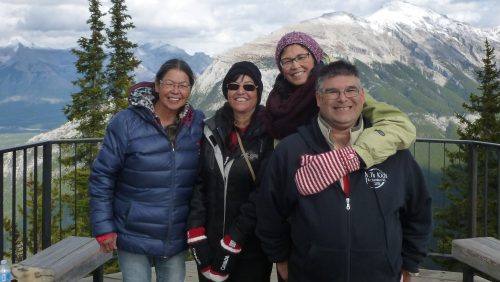
Download
Loading...
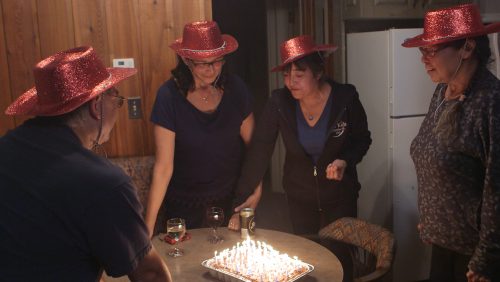
Download
Loading...
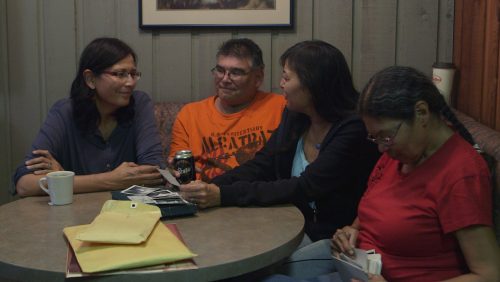
Download
Loading...

Download
Loading...
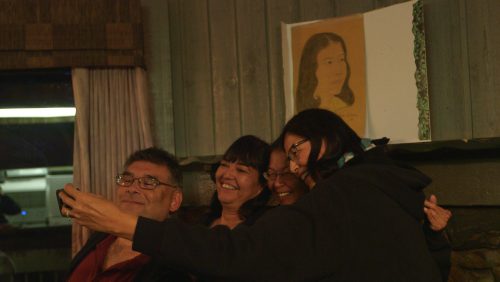
Download
Loading...
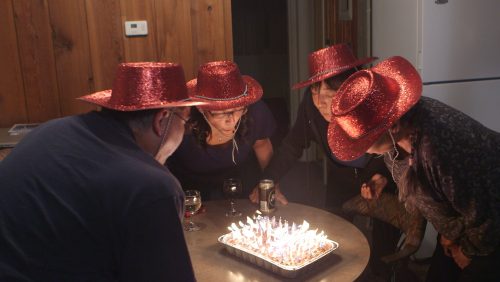
Download
Loading...
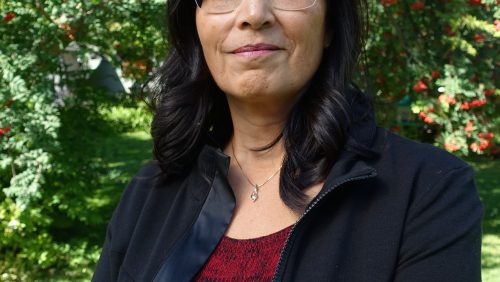 Photo: Tasha Hubbard
Photo: Tasha Hubbard
Download
Loading...
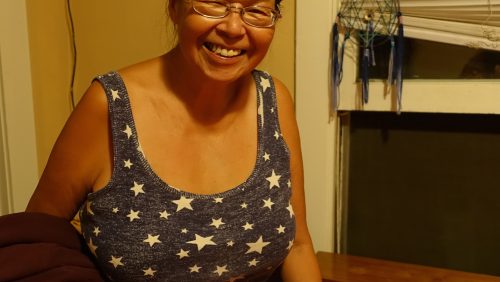 Photo: Tasha Hubbard
Photo: Tasha Hubbard
Download
Loading...
 Photo: Tasha Hubbard
Photo: Tasha Hubbard
Download
Loading...
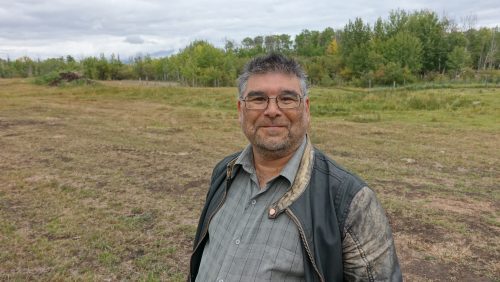 Photo: Tasha Hubbard
Photo: Tasha Hubbard
Download
Loading...
 Photo: Bonnie Thompson
Photo: Bonnie Thompson
Download
Loading...
 Photo: Tasha Hubbard
Photo: Tasha Hubbard
Download
Team
Tasha Hubbard
Director
Photo
Photo : Nadya Kwandibens
Bonnie Thompson
Producer (NFB)
Photo
Photo : Debbie Boccabella
David Christensen
Producer & Executive Producer
Photo
Credits
Between 1955 and 1985, the Canadian and provincial governments
removed an estimated 20,000 Indigenous children from their homes
and placed them in the child welfare system.
Four children were taken from Mary Jane Adam, a Dene single mother.
Ben
Taken as a baby in 1965
ROSE
Taken as a baby in 1963
Esther
Taken as a baby in 1961
Betty ANN
Taken as a baby in 1961
Betty Ann, the eldest, found her siblings over the course of several decades.
This will be the first time all four of Mary Jane’s kids come together.
This will be the first time all four of Mary Jane’s kids come together.
Thank you to
Betty Ann
Esther
Rose
Ben
Written by
Tasha Hubbard &
Betty Ann Adam
Directed by
Tasha Hubbard
Producer
Bonnie Thompson
Executive Producer
David Christensen
Editor
Hans Olson
Consulting Editor
Scott Parker
Director of Photography
Allan Leader
Cinematographers
Thomas Dudley
Jim Moule
Production Manager
Darin Wilson
Location Sound
Per Asplund
Brad Martin
Sound Design
Perry Blackman
Blackman Productions
Mixer
Serge Boivin
Colourist
Serge Verreault
Titles
Jacques Bertrand Simard
Data Management
Oliver Lessard
Transcription
Patricia Garry
Special Thanks
Marie Wilson The Willie Dunn Family
Trisha Polard Connie Grace
Angelika Eirisch Joanne Wilson
Ian Burt Lucia Diakuw
Quannah Duquette Robert McIntyre
Joanne Taylor Gisele Gordon
Danis Goulet Lisa Jackson
Marcel Balfour Tanya Harnett
Eleanore Sunchild Raven Sinclair
Heather Persson Rose Pacquette
Raymond Adam
Thanks
Calgary Airport
Enterprise Rent a Car, Calgary International Airport
Town of Banff
Banff National Park
Buffalo Nations Luxton Museum
Douglas Fir Resort & Chalet
Fairmont Banff Springs/Chateau Lake Louise
Spirit of Christmas
Banff Photography
Great Canadian Dollar Store
Glacier Adventure Tour
Glacier Skywalk
Brewster Inc.
Card 19
Music
I Pity the Country
Willie Dunn
Available on
Native North America (VOL. 1)
Aboriginal Folk, Rock And Country 1966 -1985
℗ 2014 Light in The Attic Records & Distribution
Associate Producer
Betty Ann Adam
Production Coordinators
Jasmine Pullukatt
Ginette D’Silva
Faye Yoneda
Production Supervisors
Mark Power
Esther Viragh
Marketing Manager
Leslie Stafford
Program Administrator
Bree Beach
Ginette D’Silva
Centre Operations Manager
Darin Clausen
Executive Director, English Programming and Production
Michelle Van Beusekom

Media Relations
-
About the NFB
For more than 80 years, the National Film Board of Canada (NFB) has produced, distributed and preserved those stories, which now form a vast audiovisual collection—an important part of our cultural heritage that represents all Canadians.
To tell these stories, the NFB works with filmmakers of all ages and backgrounds, from across the country. It harnesses their creativity to produce relevant and groundbreaking content for curious, engaged and diverse audiences. The NFB also collaborates with industry experts to foster innovation in every aspect of storytelling, from formats to distribution models.
Every year, another 50 or so powerful new animated and documentary films are added to the NFB’s extensive collection of more than 14,000 titles, half of which are available to watch for free on nfb.ca.
Through its mandate, its stature and its productions, the NFB contributes to Canada’s cultural identity and is helping to build the Canada of tomorrow.